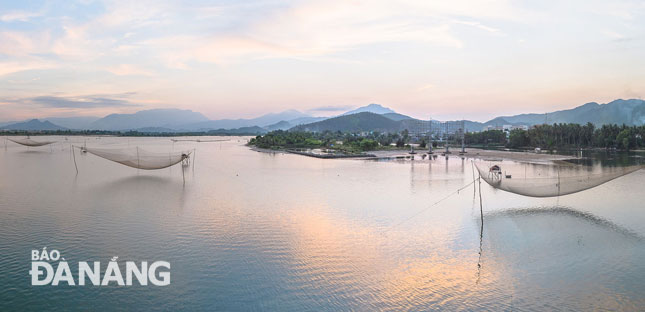Lien Chieu District eyes ways to boost tourism development
Lien Chieu District boasts a number of inviting venues which join a list of Da Nang’s must-see places as Nam O fishing village, Luong Stream, the landscapes along the banks of Cu De River, Xuan Thieu Beach, Hai Van Gate, and hundreds of historical relic sites.
 |
| The Cu De River is expected to become a must-visit place in Lien Chieu District in the near future |
More recently, the municipal People’s Committee has approved the detailed plan for the development of tourism sites along the banks of the Cu De River with a total planned area of 10.971 m2, in Hoa Hiep Bac Ward, Lien Chieu District.
Under the construction plan, there will a 733m2 area consisting of wharves, piers, ticket counters, and locations for picking up and dropping off passengers.
Also, a 2,118m2 venue for developing restaurants, souvenir shops, agricultural products, fishing villages, and festival spaces will be created there.
In particular, the 2,609m2 Ba Temple and the 5, 511m2 Thuy Tu communal village house will be embellished but kept unchanged, whilst green parks for the organisation of festivals will be created at these sites.
As per the request from the municipal government, the Lien Chieu District administration is coordinating with the Da Nang Urban Planning Institute to make clear boundary statements to direct the things that are applicable to those areas within the scope of the project.
Lien Chieu District People's Committee Chairman Dam Quang Hung asked the municipal authorities to faciliate the creation of the new attractive tourist sites along the banks of the Cu De River soon.
In addition, more incentives should be issued so as to help the district attract even more businesses from both home and abroad to pour their money into its tourism services.
Apart from fully tapping the river tourism development potential, the district is blessed with many communal village houses temples and shrines. Noticeably, the communal village houses of Trung Nghia, Hoa My, Da Son and Xuan Duong have been recognised as city-level relic sites.
Mr Tran Chi Cuong, the Deputy Director of the municipal Department of Tourism, said that focus would be on fostering the tourism development of traditional craft villages such as the Nam O fish sauce village along the galloons of Kim Lien and Nam Chon.
In addition to immersing themselves into the allure of beautiful natural landscapes, visitors can explore the Nam O fishing village’s culinary culture with such yummy specialities as ‘goi ca’ (raw fish salad) and seaweed jams, and many kinds of seafood.
In his remarks, Mr Huynh Tan Vinh, the Chairman of the Da Nang Tourism Association, raised his concern over the current shortage of transportation and accommodation and auxiliary services along with advertising strategies. These challenging issues are hindering the progress of the district’s tourism industry.
In his point of view, Mr Vinh pointed out to the fact that a challenging task under the project for developing tourism sites along the banks of the Cu De River is how to effectively appeal for local fishermen to convert their fishing vessels into tourist boats, whilst ensuring stable incomes from tourism activities for them.